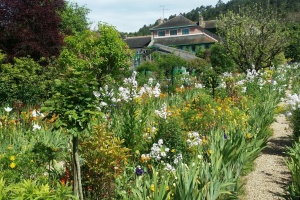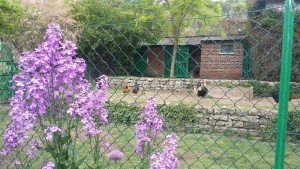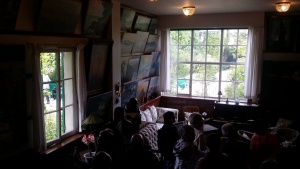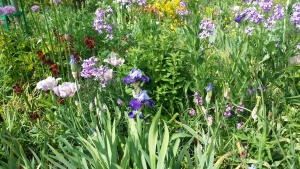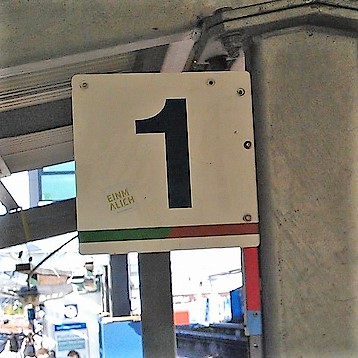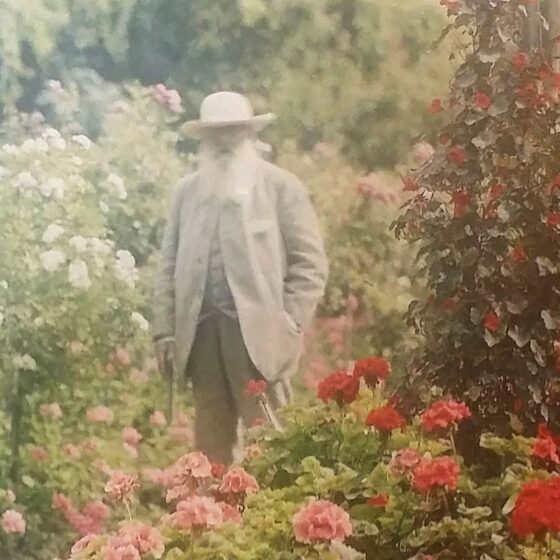
Impression of Monet’s Garden
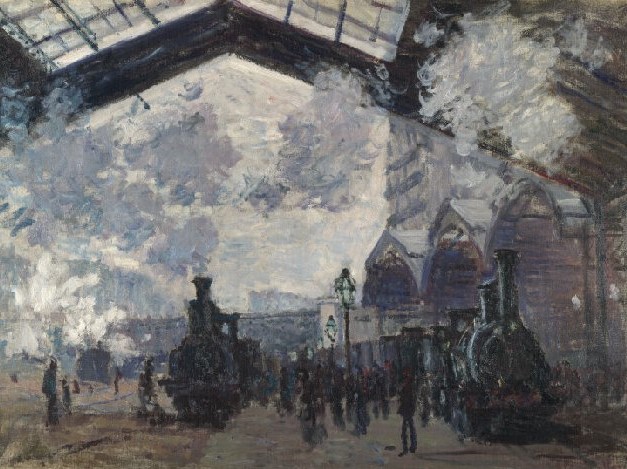 Most major attractions want you to pre-book and pay online. A barcode is sent to your smart phone which you flash over a reader at your destination. Note: It’s only a smart phone if it has a smart user. I’ll take my chances at the gate.
Most major attractions want you to pre-book and pay online. A barcode is sent to your smart phone which you flash over a reader at your destination. Note: It’s only a smart phone if it has a smart user. I’ll take my chances at the gate.
It’s spring. I’m in Paris. What better time to board a train and spend the day at Monet’s house and garden.
Dimanche, 9:17am, Gare St Lazare, Quai 23
The ticket I am squeezing the life out of cost €14.70. The return ticket, same cost, is tucked into the French language ticket wallet. I haven’t a clue what it reads but I feel reckless and bohemian. I wish I was wearing a beret. This is Monet’s station. He commuted in and out of here. He did a series of twelve paintings featuring the steam trains entering under the huge overhead iron girders supporting the roof. That’s them above me now. I could be standing exactly where he stood, and I am about to replicate his commute; Paris – Vernon – Giverny.
I am convinced the train will be coal fired. A hiss of steam enveloping the platform with the piercing scream of the whistle echoing to the glass panelled roof signalling my departure. I’ll disappear, gathering speed into the impressionistic light of the French countryside.
Today is overcast, dour, the light heavy. This train is modern, sleek. It travels silently and goes like the clappers. The seats are comfortable.
Vernon
Here’s your stop. Fall in step and follow the crowd to the shuttle bus. Buy your €10 return ticket as you board. The bus winds through the quaint little village, over the river Seine via the Pont Clemenceau, a tight right turn into the route to Giverny.
Giverny
Monet’s retreat. If he was seeking anonymity too bad, his Maison is in rue Claude Monet. Not hard to find, everyone in the little lanes of Giverny is heading there. It took a minute to realise the pink rendered wall I leaned against sheltering from the sudden rain shower is the outside of his house.
The queue moved briskly, €9.50 got me inside. In the austere entrance hallway, the grey sky blew away revealing Monet’s inspiration, the provincial sunshine. I stepped into his garden. Glowing with colour the throats of spring blooms glistened with droplets of water. Tulips, poppies, wallflowers, pansies, violas, blue and white salvia, forget-me-nots, stocks, foxgloves, roses, azaleas, rhododendrons, and most spectacularly beds of wild iris. Everything shone. Everything smelt fresh, even the chook pen.
Step through the Veronese green doorway and prepare for the visual and sensory assault of life inside Monet’s unprepossessing cottage. His paintings fill the house. Hushed awe takes hold of visitors. Artists’ work is important and at its best when words leave you short attempting to convey ‘remarkable’. The urge to gather everything up in your arms is overwhelming. It was just a bunch of ratty old paintbrushes but don’t touch anything, you will be admonished.
To the lily pond. Two punts moored beneath willow trees. The green Japanese bridge. White wisteria covered walkways. The pond with lily pads. The water reflects the towering red maple. The sunlight catching the leaves shimmer. Colour is deceptive. Amber, carmine, scarlet, tangerine, persimmon. The effect is calming, no-one is in a hurry. There is time to linger, deliberate, and traipse around the gardens. No manicured edges, no formal plantings, no pretention. The entire estate appears as one spontaneous outrageous burst of nature.
The air is full of humming bees, the croaking of frogs, and the perfume of spring flowers. Everywhere you look. Everything you touch. Everything you smell, hear, and feel. Just as Monet painted it.



